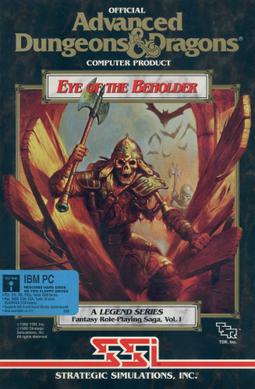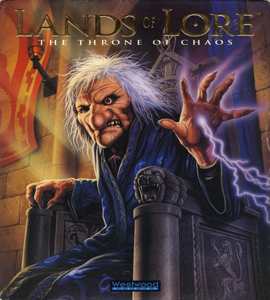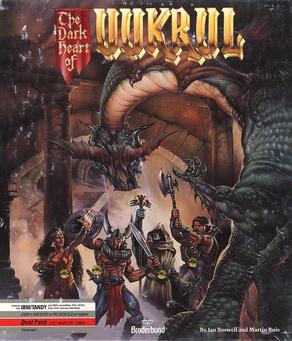
Simon the Sorcerer is a 1993 point-and-click adventure game developed and published by Adventure Soft, for Amiga and MS-DOS. The game's story focuses on a boy named Simon who is transported into a parallel universe of magic and monsters, where he embarks on a mission to become a wizard and rescue another from an evil sorcerer. The game's setting was inspired by the novels of the Discworld series, and incorporates parodies on fantasy novels and fairy tales, such as The Lord of the Rings and Jack and the Beanstalk. The lead character's design was inspired by that of the fictional British television character Blackadder, with the character voiced by Chris Barrie in the CD re-release.

Final Fantasy Mystic Quest, released as Mystic Quest Legend in PAL regions and as Final Fantasy USA: Mystic Quest in Japan, is a role-playing video game for the Super Nintendo Entertainment System. It was released as a spin-off to Square's Final Fantasy series of video games. Final Fantasy Mystic Quest was first released in North America in 1992 and marketed as a "simplified role-playing game... designed for the entry-level player" in an attempt to broaden the genre's appeal. The game's presentation and battle system is broadly similar to that of the main series, but differs in its inclusion of action-adventure game elements. It was also the first Final Fantasy game to be released in Europe.

King's Quest is a graphic adventure game series, released between 1980 and 2016 and created by the American software company Sierra Entertainment. It is widely considered a classic series from the golden era of adventure games. Following the success of its first installments, the series was primarily responsible for building the reputation of Sierra. Roberta Williams, co-founder and former co-owner of Sierra, designed all of the King's Quest games until the series' reboot in 2015.

Eye of the Beholder is a role-playing video game for personal computers and video game consoles developed by Westwood Associates. It was published by Strategic Simulations, Inc. in 1991, for the MS-DOS operating system and later ported to the Amiga, the Sega CD and the SNES. The Sega CD version features a soundtrack composed by Yuzo Koshiro and Motohiro Kawashima. A port to the Atari Lynx handheld was developed by NuFX in 1993, but was not released. In 2002, an adaptation of the same name was developed by Pronto Games for the Game Boy Advance.

Superhero League of Hoboken is an adventure and role-playing video game developed and published by Legend Entertainment. Designed by Steve Meretzky, the game combines the superhero, comedy and post-apocalypse genres. It was available on both floppy disk and CD-ROM. It uses 256 color 2D graphics. It was re-released in 2019 with support for Windows, macOS, and Linux.

Ultima II: The Revenge of the Enchantress, released on August 24, 1982, for the Apple II, is the second role-playing video game in the Ultima series, and the second installment in Ultima's "Age of Darkness" trilogy.

The Pandora Directive is the fourth installment in the Tex Murphy series of graphic adventure games produced by Access Software. After its creators reacquired the rights to the series, it was re-released on Good Old Games in July 2009.

Wizardry VII: Crusaders of the Dark Savant is the seventh title in the Wizardry series of role-playing video games by Sir-Tech Software, Inc., preceding Wizardry 8 and succeeding Wizardry VI: Bane of the Cosmic Forge. It is also the second entry in the 'Dark Savant' trilogy. The game was published in 1992 by Sir-Tech, originally developed for DOS. In 1996 it was remade into Wizardry Gold, designed to work on Windows and Macintosh, and distributed by Interplay.

Joseph David Kucan is an American video game developer, director, actor, screenwriter, and casting director for various gaming companies and films. He is a resident of Las Vegas, Nevada. He is well known for his role as Kane from the Command & Conquer series.

Quest for Glory: So You Want to Be a Hero is a 1989 adventure game/role-playing game hybrid, designed by Lori Ann Cole and published by Sierra On-Line for MS-DOS. It is the first game in the Quest for Glory series, and has been credited for being a genre-defining game, as it tried to mix graphical adventure gaming with role-playing-like elements such as statistic building that would actually affect the ability to accomplish certain parts of the game. The game has a satirical and silly tone. Ports for the Amiga, Atari ST, and NEC PC-9801 were released in the early 1990s. A VGA remake, titled Quest for Glory I: So You Want to Be a Hero, was released in 1992 for DOS and later in 1994 for Mac OS.

Eye of the Beholder III: Assault on Myth Drannor is a 1993 role-playing video game and the sequel to Eye of the Beholder and Eye of the Beholder II: The Legend of Darkmoon.

Al-Qadim: The Genie's Curse is an action role-playing game for the personal computer set in the Al-Qadim campaign setting of Advanced Dungeons and Dragons. The game was developed by Cyberlore Studios and published in 1994 by Strategic Simulations (SSI). The game combines role-playing game and adventure with a simplified interface; the player's character is a young corsair trying to clear his family's name, rescue his betrothed and determine who has been freeing genies from their masters.

Lands of Lore: The Throne of Chaos is a 1993 role-playing video game developed by Westwood Studios and published by Virgin Games for MS-DOS, the NEC PC-9801, and FM Towns. It was the first installment of the Lands of Lore series. The player travels around various environments, collecting items and battling monsters in an attempt to save the kingdom from a witch named Scotia, who has acquired shape-shifting abilities.

The Legend of Kyrandia: Book Three - Malcolm's Revenge is a 2D point-and-click adventure game, developed by Westwood Studios and published by Virgin Interactive Entertainment in 1994. It is the sequel to The Legend of Kyrandia: Hand of Fate, and the third and final game in the Fables & Fiends series. The game sees players take on the role of the antagonist from the first game in the series, who begins plotting his revenge against those who thwarted him, only to find himself eventually seeking to prove his innocence of a murder he did not commit.

Dream Chronicles, first released in 2007, is a series of adventure, hidden object and puzzle casual games. It was created by Miguel Angel Tartaj for KatGames and published by PlayFirst. It's also the name of the first game in the series.

Dracula 4: The Shadow of the Dragon is a 2013 point-and-click adventure video game developed by Koalabs Studio for Microsoft Windows, OS X, iOS, and Android. It was published on all systems by Anuman under their Microïds brand. In 2013 the game was released on GOG.com, and in 2014 was bundled with its sequel, Dracula 5: The Blood Legacy. Later in 2014, the bundle was released on Steam.

Dracula 5: The Blood Legacy is a 2013 point-and-click adventure video game developed by Koalabs Studio for Microsoft Windows, iOS, Android and OS X. It was published on all systems by Anuman under their Microïds brand. In 2014, the game was released on GOG.com and Steam, bundled with its prequel, Dracula 4: The Shadow of the Dragon.

The Dark Heart of Uukrul is a first-person perspective, turn-based fantasy computer role-playing game written by Ian Boswell and Martin Buis of Digital Studios Limited, and published by Broderbund, and later re-published by Moon Books Publishing. The game was released in 1989 on the Apple II and in 1990 on the IBM PC; in 2020 it was made available on GOG.com.

The Legend of Kyrandia: Book One is a 2D point-and-click adventure game, developed by Westwood Studios and published by Virgin Games in August 1992. The game is the first in the The Legend of Kyrandia series, and focuses on players taking on the role of a young prince who put an end to the tyrannical chaos of an evil court jester.



















